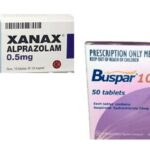Why Was Buspar Taken Off The Market?

What Is Buspar?
Buspar is a brand of buspirone a class of medications called anti-anxiety medications. Buspirone is not related to other anti-anxiety medications, such as benzodiazepines, barbiturates, or other sedative/ anxiolytic drugs. It is approved for the treatment of generalized anxiety disorder (GAD).
Buspirone was first made in 1968 and approved for medical use in the United States in 1986. It is available as a generic medication. In 2019, it was the 76th most commonly prescribed medication in the United States, with more than 9 million prescriptions.
Why was Buspar taken off the market?
Buspar is currently listed as discontinued by the United States by the Federal Drug Administration but the withdrawal of Buspar from the market is not due to safety or effectiveness.
The recent shortage of buspirone was as a result of increasing demand and the interrupted production at a Mylan Pharmaceuticals plant in Morgantown, West Virginia, the United States. One in five Americans has had an anxiety disorder in the past year, according to the National Institute of Mental Health, though relatively few use buspirone.
Experts say it is a much safer drug than benzodiazepine anti-anxiety drugs like Valium and Xanax and is unlikely to cause harm from an overdose or when combined with other medications like opioids. It is not addictive, has few side effects, does not cause sexual dysfunction, and is remarkably inexpensive.
Are There Specific Concerns About Buspar And Pregnancy?
If you are planning on becoming pregnant, notify your health care provider to best manage your medications. People living with anxiety disorders who wish to become pregnant face important decisions. It is important to discuss this with your doctor and caregivers. Regarding breastfeeding, caution is advised since it is unknown whether Buspar passes into breast milk.
What are the possible side effects of Buspar?
Common side effects
• Nausea, headache, or changes in dreams
• Feeling dizzy, drowsy, or lightheaded
Rare/serious side effects
Changes in weight or appetite, fainting, changes in blood pressure, muscle cramps or spasms, and redness or itching of eyes may occur in some instances.
Allergic reaction (difficulty breathing; hives; swelling of your lips, tongue, or face); chest pain or an irregular heartbeat; slurred speech; confusion or blurred vision; numbness or tingling in your hands, feet, arms, or legs; or uncontrollable movements of your arms, legs, tongue, or lips.
Are there any risks for taking Buspar for long periods of time?
To date, there are no known problems associated with the long-term use of Buspar. It is a safe and effective medication when used as directed.
What other medications may interact with Buspar?
If you have taken a monoamine oxidase inhibitor (MAOI), such as phenelzine (Nardil®), isocarboxazid (Marplan®), selegiline (Eldepryl®, EMSAM®) or tranylcypromine (Parnate®), within the past 2 weeks, do not take buspirone. The use of buspirone with these agents can cause a severe increase in your blood pressure.
The following medications may increase the levels and effects of buspirone:
• Diltiazem (Cardizem®, Dilacor®, Tiazac®)
• Verapamil (Calan®, Covera-HS®, Isoptin®, Verelan®)
• Erythromycin (E-Mycin®, E.E.S.®, Ery-Tab®, Eryc®, others)
• Consuming large amounts of grapefruit juice can increase the amount of buspirone in your blood
The following medications may decrease the levels and effects of buspirone:
• Rifampin (Rifadin®, Rimactane®, Rifampicin®, others)
How long does it take for Buspar to work?
It may take 3 to 4 weeks of taking Buspar every day before you start to feel better.
Summary Of FDA Black Box Warnings
There are no FDA black box warnings for buspirone.



